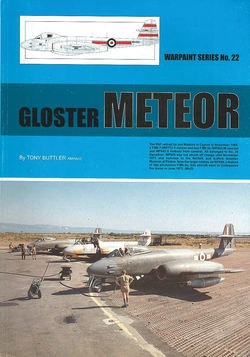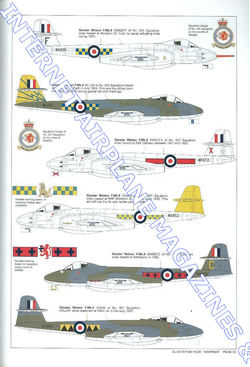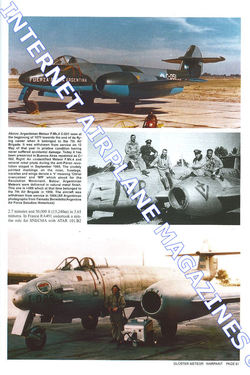-------------------------------------------------------------------------
Additional information from Internet
Encyclopedia
The Gloster Meteor was the first British
jet fighter and the Allies' only operational jet aircraft during the Second
World War. The Meteor's development was heavily reliant on its ground-breaking
turbojet engines, pioneered by Sir Frank Whittle and his company, Power Jets
Ltd. Development of the aircraft itself began in 1940, although work on the
engines had been under way since 1936. The Meteor first flew in 1943 and
commenced operations on 27 July 1944 with No. 616 Squadron RAF. Nicknamed the
"Meatbox", the Meteor was not a sophisticated aircraft in its
aerodynamics, but proved to be a successful combat fighter.
Several major
variants of the Meteor incorporated technological advances during the 1940s and
1950s. Thousands of Meteors were built to fly with the RAF and other air forces
and remained in use for several decades. The Meteor saw limited action in the
Second World War. Meteors of the Royal Australian Air Force (RAAF) provided a
significant contribution in the Korean War. Several other operators such as
Argentina, Egypt and Israel flew Meteors in later regional conflicts. Specialised
variants of the Meteor were developed for use in photographic aerial
reconnaissance and as night fighters.
Despite the
revolutionary turbojet propulsion used, the design of the Meteor was relatively
orthodox and did not take advantage of many aerodynamic features utilised on
other jet fighters, such as swept wings; the Meteor shared a broadly similar
basic configuration to its German equivalent, the Messerschmitt Me 262.
It was an
all-metal aircraft with a tricycle undercarriage and conventional low, straight
wings with mid-mounted turbojet engines and a high-mounted tailplane clear of
the jet exhaust. The Meteor F.1 exhibited some problematic flying
characteristics typical of early jet aircraft; it suffered from stability
problems at high transonic speeds, large trim changes, high stick forces and
self-sustained yaw instability (snaking) caused by airflow separation over the
thick tail surfaces. The longer fuselage of the Meteor T.7, a two-seater
trainer, significantly reduced the aerodynamic instability that the early
Meteors were known for.
Later Meteor
variants would see a large variety of changes from the initial Meteor F.1
introduced to service in 1944. Much attention was given to raising the
aircraft's top speed, often by improving the airframe's aerodynamic qualities,
incorporating the latest engine developments, and increasing the strength of
the airframe.
From the outset,
each Meteor was constructed from several modular sections or separately
produced units; this was a deliberate design choice to allow for production to
be dispersed and for easy disassembly for transport. Each aircraft comprised
five main sections: nose, forward fuselage, central section, rear fuselage and
tail units; the wings were also built out of lengthwise sections. The forward
section contained the pressure cabin, gun compartments, and forward
undercarriage. The center section incorporated much of the structural elements,
including the inner wing, engine nacelles, fuel tank, ammunition drums, and
main undercarriage. The rear fuselage was of a conventional semi-monocoque
structure. Various aluminium alloys were the primary materials used throughout
the structure of the Meteor, such as the stressed duralumin skin.
Across the
Meteor's production life, various different companies were subcontracted to
manufacture aircraft sections and major components; due to the wartime workload
on producing fighter aircraft such as the Hawker Hurricane and Hawker Typhoon,
neither Gloster nor the wider Hawker Siddeley Group were able to internally
meet the production demand of 80 aircraft per month. Bristol Tramways produced
the forward fuselage of the aircraft, the Standard Motor Company manufactured
the central fuselage and inner wing sections, the Pressed Steel Company
produced the rear fuselage, and Parnall Aircraft made the tail unit. Other main
subcontractors included Boulton Paul Aircraft, Excelsior Motor Radiator
Company, Bell Punch, Turner Manufacturing Company, and Charlesworth Bodies; as
many of these firms had little or no experience producing aircraft, both
quality and interchangeability of components were maintained by contractually
enforced adherence to Gloster's original drawings.
No. 616 Squadron
exchanged its F.1s for the first Meteor
F.3s on 18 December 1944. These first 15 F.3s differed from the F.1
in having a sliding canopy in place of the sideways hinging canopy, increased
fuel capacity and some airframe refinements. They were still powered by Welland
I engines. Later F.3s were equipped with the Derwent I engines. This was a
substantial improvement over the earlier mark, although the basic design still
had not reached its potential. Wind tunnel and flight tests demonstrated that
the original short nacelles, which did not extend far fore and aft of the wing,
contributed heavily to compressibility buffeting at high speed. New, longer
nacelles not only cured some of the compressibility problems but added
120 km/h (75 mph) at altitude, even without upgraded powerplants. The
last batch of Meteor F.3s featured the longer nacelles; other F.3s were
retrofitted in the field with the new nacelles. The F.3 also had the new
Rolls-Royce Derwent engines, increased fuel capacity, and a new larger, more
strongly raked bubble canopy.
Judging the Meteor F.3s were ready for combat
over Europe, the RAF finally decided to deploy them on the continent. On 20
January 1945, four Meteors from 616 Squadron were moved to Melsbroek in Belgium
and attached to the Second Tactical Air Force, just under three weeks after the
Luftwaffe's surprise Unternehmen Bodenplatte attack on New Year's Day, in which
Melsbroek's RAF base, designated as Allied Advanced Landing Ground
"B.58", had been struck by the piston-engined fighters of JG 27 and
JG 54. The 616 Squadron Meteor F.3s' initial purpose was to provide air defence
for the airfield, but their pilots hoped that their presence might provoke the
Luftwaffe into sending Me 262s against them. At this point the Meteor pilots
were still forbidden to fly over German-occupied territory, or to go east of
Eindhoven, to prevent a downed aircraft being captured by the Germans or the
Soviets.
In March, the entire squadron was moved to
Gilze-Rijen and then in April, to Nijmegen. The Meteors flew armed
reconnaissance and ground attack operations without encountering any German jet
fighters. By late April, the squadron was based at Faßberg, Germany and
suffered its first losses when two aircraft collided in poor visibility. The
war ended with the Meteors having destroyed 46 German aircraft through ground
attack. Friendly fire through misidentification as Messerschmitt Me 262s by
Allied anti-aircraft gunners was more of a threat than the already-diminished
forces of the Luftwaffe; to counter this, continental-based Meteors were given
an all-white finish as a recognition aid. The nearest No.616 squadron came to a
jet-to-jet battle came on 19 March, when a force of Arado Ar 234 jet bombers
attacked their airfield.
The F.4 had the Rolls-Royce
Derwent 5 engines (a smaller version of the Nene), wings 86.4 cm shorter than
the F.3's and with blunter tips (derived from the world speed record
prototypes), a stronger airframe, fully pressurized cockpit, lighter ailerons
(to improve manoeuvrability), and rudder trim adjustments to reduce snaking.
The F.4 could also be fitted with a drop tank under each wing.
Because of the increased demand,
F.4 production was divided between Gloster and the Armstrong Whitworth factory
at Baginton. The majority of early F.4s did not go directly to the RAF: 100
were exported to Argentina (and saw action on both sides in the 1955
revolution, one being lost on 19 September 1955) while in 1947, only RAF Nos.
74 and 222 Squadrons were fully equipped with the F.4. Nine further RAF
squadrons were upgraded over 1948. From 1948, 38 F.4s were exported to the
Dutch, equipping four squadrons (322, 323, 326 and 327) split between bases in
Soesterberg and Leeuwarden until the mid-1950s. In 1949, only two RAF squadrons
were converted to the F.4, Belgium was sold 48 aircraft in the same year (going
to 349 and 350 Squadrons at Beauvechain) and Denmark received 20 over 1949–50.
In 1950, three more RAF squadrons were upgraded, including No. 616 and, in
1951, six more. In 1950, a single order of 20 F.4s was delivered to Egypt.
A modified two-seater F.4 for
jet-conversion and advanced training was tested in 1949 as the T.7. It was
accepted by the RAF and the Fleet Air Arm and became a common addition to the
various export packages (for example 43 to Belgium 1948–57, a similar number to
the Netherlands over the same period, two to Syria in 1952, six to Israel in
1953, etc.). Despite its limitations—unpressurized cockpit, no armament,
limited instructor instrumentation—over 650 T.7s were manufactured.
While various marks of Meteor
had been introduced by 1948, they had remained fundamentally very similar to
the prototypes of the Meteor; consequently, the performance of the Meteor F.4
was beginning to be eclipsed by entirely new jet designs. Thus, Gloster
embarked on a major redesign program to produce a new version of the Meteor
with considerable performance increases, introducing new equipment and
technologies to help the new aircraft meet the increasingly-demanding
operational requirements of the RAF. Designated Meteor F.8, this upgraded
variant was a highly potent fighter aircraft, forming the bulk of RAF Fighter
Command between 1950 and 1955; the Meteor would continue to be widely operated
by a number of nations into the 1960s.
Flight testing of the F.8
prototype led to the discovery of an aerodynamic problem: when ammunition was
expended, the aircraft became tail heavy and unstable around the pitch axis due
to the weight of fuel retained in fuselage tanks no longer being balanced by
the ammunition. Gloster solved the problem by substituting the tail of the
abortive "G 42" single-engined jet fighter. The F.8 and other
production variants successfully used the new tail design, giving the later
Meteors a distinctive appearance, with taller straighter edges compared with
the rounded tail of the F.4s and earlier marks.
The F.8 also featured a fuselage
stretch of 76 centimetres (30 inches), intended to shift the aircraft's centre
of gravity and also eliminate the use of ballast that had been necessary in
earlier marks. The F.8 incorporated uprated engines, Derwent 8s, with 16 kN
(1,633 kgp / 3,600 lbf) thrust each combined with structural strengthening, a
Martin Baker ejection seat and a "blown" teardrop cockpit canopy that
provided improved pilot visibility. Between 1950 and 1955, the Meteor F.8 was
the mainstay of RAF Fighter Command.
Initial deliveries of the F.8 to
the RAF were in August 1949, with the first squadron receiving its fighters in
late 1950. Like the F.4, there were strong export sales of the F.8. Belgium
ordered 240 aircraft, the majority assembled in The Netherlands by Fokker. The
Netherlands had 160 F.8s, equipping seven squadrons until 1955. Denmark had 20,
ordered in 1951; they were to be the last F.8s in front line service in Europe.
The RAAF ordered 94 F.8s, which served in the Korean War. Despite arms
embargoes, both Syria and Egypt received F.8s from 1952, as did Israel (where
they served until 1961). On 1 September 1955, two Israeli F.8s shot down two
Egyptian Vampires and in the 1956 Suez Crisis, F.8s were employed by both Egypt
and Israel in ground attack roles. After the crisis, both Egypt and Syria
disposed of their Meteors in favour of various MiG variants. Brazil ordered 60
new Meteor F.8s and 10 T.7 trainers in October 1952
In the 1950s, Meteors also were
developed into effective photo-reconnaissance, training and night fighter
versions. The fighter reconnaissance (FR) versions were the first to be built,
replacing the ageing Spitfires and Mosquitos then in use. Two FR.5s were built
on the F.4 body; one was used for nose section camera tests and the other broke
up in midair while in testing over Moreton Valence. On 23 March 1950, the first
FR.9 flew. Based on the F.8, it was 20 cm longer with a new nose incorporating
a remote control camera and window and was also fitted with additional external
ventral and wing fuel tanks. Production of the FR.9 began in July. No. 208
Squadron, then based at Fayid, Egypt was the first to be upgraded followed by
the 2nd Tactical Air Force in West Germany, No. 2 Squadron RAF at Bückeburg and
No. 79 Squadron RAF at RAF Gutersloh flew the FR.9 from 1951 until 1956. In
Aden, No. 8 Squadron RAF was given the FR.9 in November 1958 and used them
until 1961. Ecuador (12), Israel (7) and Syria (2) were the only foreign
customers for the FR.9
Gloster also developed the PR.10
for high altitude missions. Based on the F.4, it had the F.4-style tail and the
longer wings of the earlier variant. All the cannons were removed and a single
camera placed in the nose with two more in the rear fuselage; the canopy was
also changed. The PR.10 was delivered to the RAF in December 1950 and were
given to No. 2 and No. 541 Squadrons in Germany and No. 13 Squadron RAF in
Cyprus.
Although proposed by Gloster,
Armstrong Whitworth did both the detail design and production for the first
meteor nightfighter. Based on the T.7
twin seater, it used the fuselage and tail of the F.8, and the longer wings of
the F.3. An extended nose contained the AI Mk 10 (the 1940s Westinghouse
SCR-720) Air Intercept radar. As a consequence the 20 mm cannons were moved
into the wings, outboard of the engines. A ventral fuel tank and wing mounted
drop tanks completed the Armstrong Whitworth Meteor NF.11
Nos. 29, 141 and 85 Squadrons
were given the NF.11 in 1951 and the aircraft was rolled out across the RAF
until the final deliveries in 1955. A "tropicalised" version of the
NF.11 for Middle East service was developed; first flying on 23 December 1952
as the NF.13. The aircraft equipped No. 219 Squadron RAF at Kabrit and No. 39
Squadron at Fayid, both in Egypt. The aircraft served during the Suez crisis
and remained with No. 39 Squadron when they were withdrawn to Malta until 1958.
Belgium (24), Denmark (20), Australia (one) and France (41) were the foreign
customers for the NF.11. Ex-RAF NF.13s were sold to Syria (six), Egypt (six)
and Israel (six).
As radar technology developed, a
new Meteor night fighter was developed to use the improved US-built APS-21
system designated as the NF.12. The
final Meteor night fighter was the NF.14.
Australia's F.8s saw extensive
service during the Korean War with No. 77 Squadron RAAF, part of British
Commonwealth Forces Korea, and had personnel from other Commonwealth air forces
attached to it. The squadron had arrived in Korea equipped with piston engine
aircraft, the F-51D Mustangs. In order to match the threat posed by Communist
MiG-15 jet fighters, it was decided to reequip the squadron with Meteors. The squadron moved to Kimpo Air Base in
June. On 29 July 1951, 77 Squadron began
operating their Meteors on combat missions and on 1 December, during a clash
between 12 Meteors and some 40 MiG-15s, the squadron had its first two
confirmed victories: Flying Officer Bruce Gogerly made the first kill. At the
end of 1951, 77 Squadron and its Meteors were assigned to ground attack duties
due to their favourable low-level performance and sturdy construction. The last encounter between the Meteor and the
MiG-15 was in March 1953, during which a Meteor piloted by Sergeant John Hale
recorded a victory.








